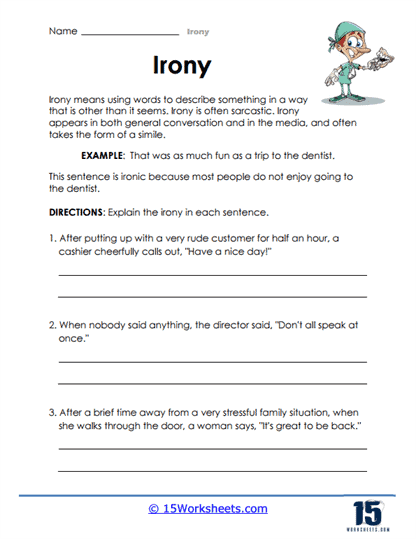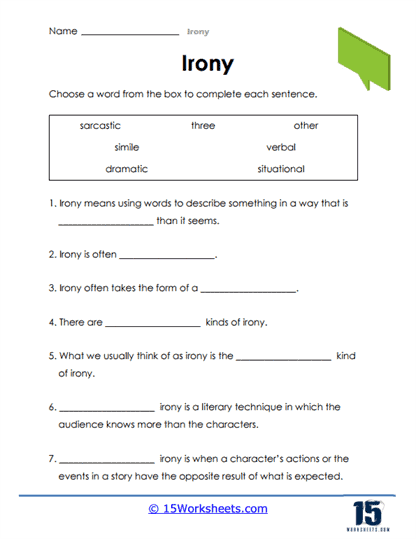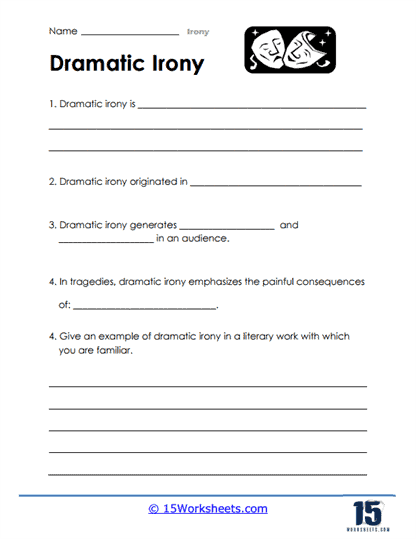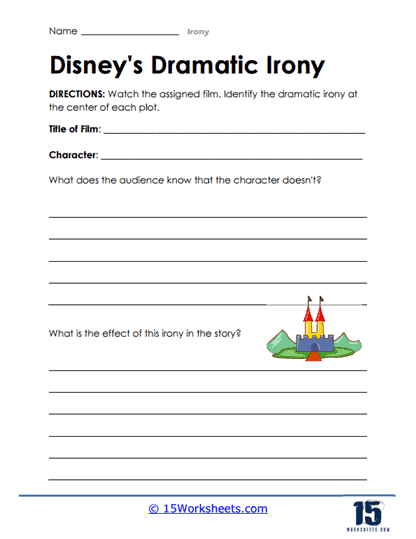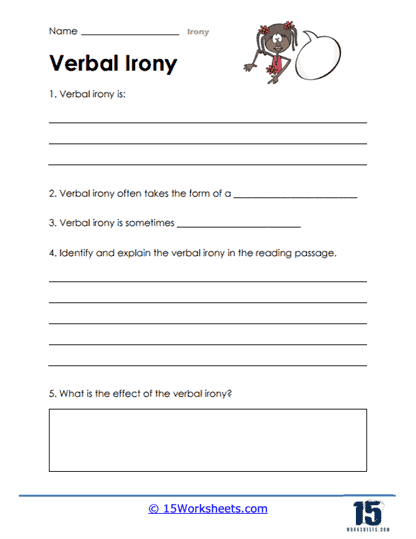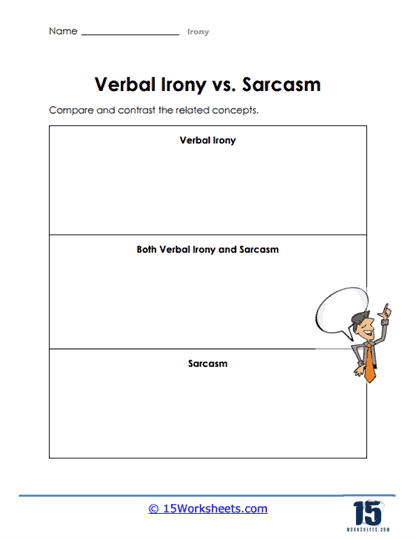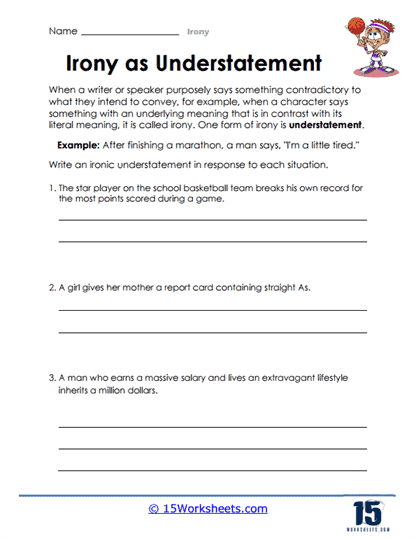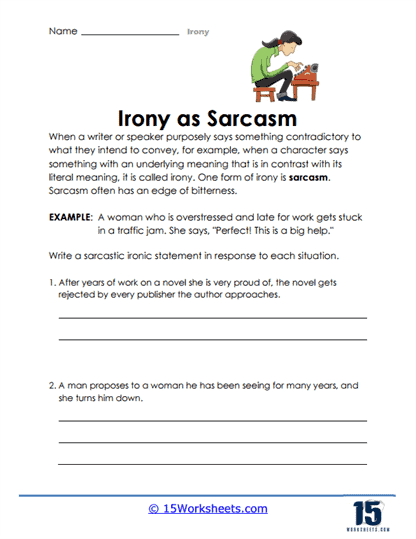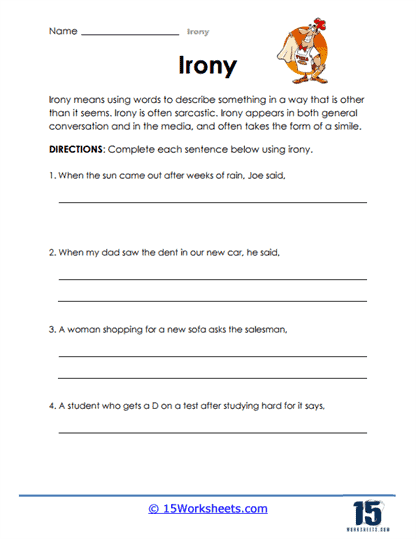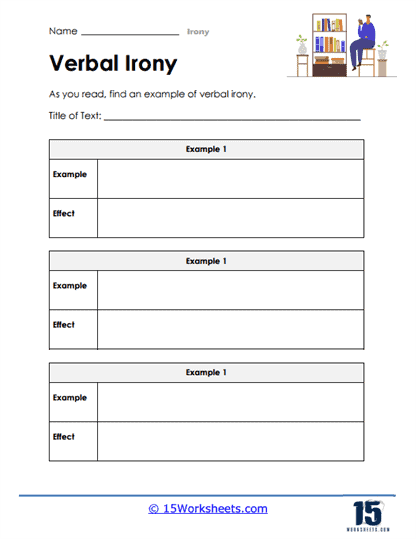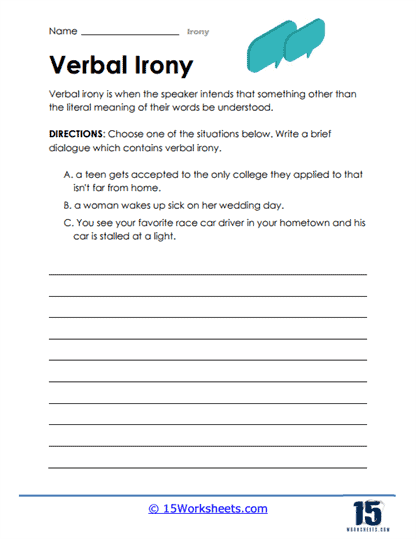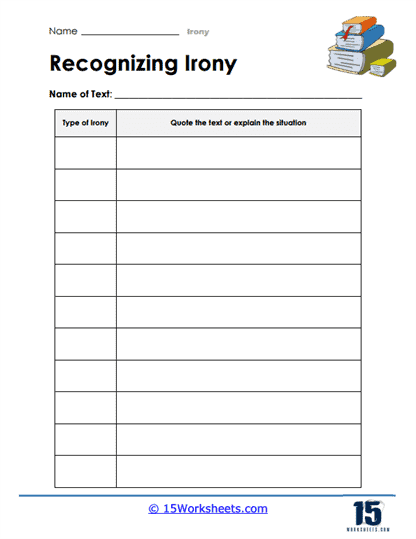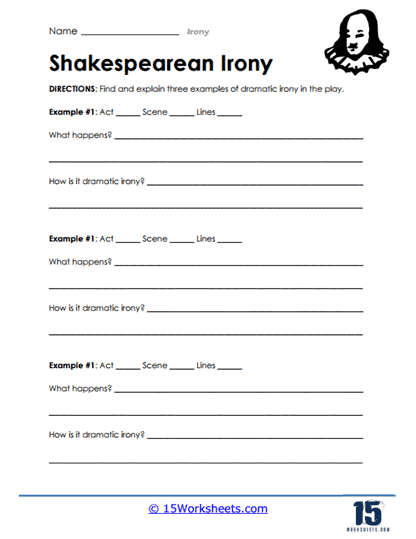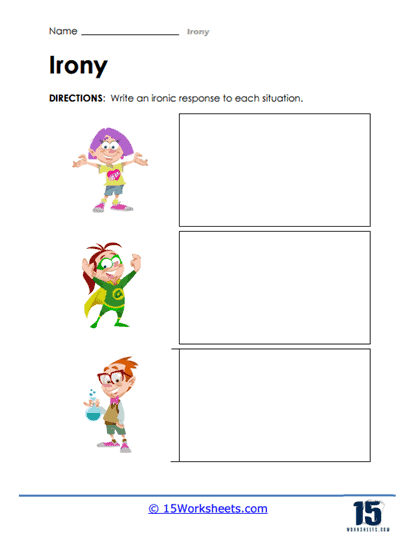Irony Worksheets
About These 15 Worksheets
Irony is a fascinating and powerful literary device that adds depth and intrigue to both storytelling and everyday language. It creates a contrast between expectations and reality, often resulting in surprising twists that challenge the way we see the world. These irony worksheets are designed to help you not only recognize irony but also engage with it on a deeper level. By understanding irony, you’ll unlock new layers of meaning in literature and sharpen your ability to detect its nuances in everyday conversation.
Imagine someone steps into a heavy rainstorm and says, “What a beautiful day!” This is an example of verbal irony, where the speaker says the opposite of the truth. Irony like this relies on the audience recognizing the contradiction between what is said and what is actually happening. These worksheets will guide you through various examples, teaching you how to spot irony in language and literature, whether it’s a playful twist of words or a deeper commentary on life’s unpredictability.
Irony comes in many forms, each adding its own flair to storytelling. Situational irony, for instance, occurs when events unfold in an unexpected way, defying logical assumptions, such as a fire station burning down. Meanwhile, dramatic irony builds tension by allowing the audience to know something the characters don’t, creating suspense and engagement. The worksheets provide exercises that help you identify these types of irony and understand their impact in shaping narratives.
Working through these worksheets not only helps you understand how irony works but also sharpens your critical thinking skills. Irony invites us to look beyond the surface and question assumptions. As you dive into passages and scenarios, you’ll learn to identify how irony creates humor, suspense, or even tragedy, enhancing your ability to analyze and appreciate the depth of literary works.
By using these irony worksheets, you’ll gain a greater appreciation for the complexity of language and storytelling. Whether it’s in literature or daily conversations, irony adds richness to communication, offering new perspectives and unexpected surprises. As you practice recognizing irony, you’ll become a more perceptive reader and communicator, ready to engage with the world in a more thoughtful and creative way.
Types of Exercises
By working on irony worksheets, you can:
Identify Irony – Irony worksheets help you develop the skill of recognizing irony in language. By reading sentences or passages, you learn to identify situations where there is a contrast between what is expected and what actually happens. This skill allows you to appreciate the nuances and surprises that irony brings to communication.
Understand Types of Irony – Irony worksheets allow you to explore different types of irony. There are several types of irony, such as verbal irony (saying the opposite of what is meant), situational irony (when the outcome is different from what is expected), and dramatic irony (where the audience or readers know something that the characters do not). By understanding these different types, you gain insight into the various ways irony is used in language and literature.
Analyze Meaning and Effect – Irony worksheets help you analyze the meaning and effect of irony in texts. You explore how irony adds depth, humor, or a sense of contradiction to the message or story. By understanding irony, you can appreciate the layers of meaning and the impact it has on the overall narrative.
Enhance Reading Comprehension – Developing the skill to identify and understand irony enhances your overall reading comprehension. Irony often reveals important information, creates plot twists, or challenges assumptions. By successfully recognizing irony, you deepen your understanding of the story and engage more fully with the narrative.
Appreciate Literary Devices – Irony is a literary device used by authors to captivate readers and create memorable moments. By working on irony worksheets, you develop an appreciation for the artistry and effectiveness of literary devices. You recognize how authors strategically use irony to add complexity, surprise, and deeper meaning to their writing.
What is Irony?
Irony is when what happens differs from what was expected to happen. It is used in speech, literature, and media to inject humor and add tension, suspense, and fear. There are three broad categories of irony: dramatic, situational, and verbal.
1. Dramatic Irony
Dramatic irony is when the reader or audience knows more about a situation than the characters. It creates suspense as the reader eagerly waits for the character to discover what is happening.
For example, a story’s main character is waiting for her long-lost half-brother to arrive at a bus station. The reader knows that the half-brother never got on that bus, but the main character doesn’t as she waits hopefully.
Another example of dramatic irony used to create suspense is when the reader knows a killer is in the house, but the main character doesn’t as they walk around carefree. This irony is exemplified perfectly in the infamous shower scene from Hitchcock’s thriller Psycho. The character Marion is taking a shower, completely unaware that someone has snuck into her room with the intent to murder her. The audience knows the murderer is sneaking up on Marion, thus creating tension as they wait to see if she is killed or not.
Dramatic irony was one of William Shakespeare’s favorite writing ploys, as seen in his play Macbeth. The audience knows that Macbeth is just pretending to be loyal to Ducan while plotting his murder.
2. Situational Irony
Also known as the irony of events, situational irony is when entirely the opposite happens than what was supposed to. Such situations have contradictions or surprises but are not the same as coincidence or bad luck.
If someone gets hit by lightning, it is bad luck, not irony. However, suppose someone gets struck by lightning after jumping to avoid a falling tree. This case is ironic because the person tried to avoid getting hurt but was nevertheless harmed by a lightning bolt.
Other examples include an ambulance crashing into another vehicle, a fire station on fire, and a police station being held at gunpoint. In all these instances, what happens is the opposite of what is expected.
In storytelling, situational irony can also put a character in an impossible situation or create a plot twist. The short story, A Lamb to a Slaughter by Roald Dahl, tells how a wife kills her husband, hitting him over the head with a frozen raw lamb leg. She then cooks and feeds it to the police, who came to investigate and collect evidence, not realizing they ate the murder weapon.
3. Verbal Irony
Verbal irony is when one person says something but means something else. There are four general types of verbal irony; sarcasm, overstatements, understatements, and Socratic irony.
An example of sarcastic verbal irony is saying, “What wonderful weather we are having” during a raging thunderstorm when such weather is not considered good.
An overstatement takes the situation to an extreme, for example, when someone says, “If I eat another slice of pizza, I will explode!” or “I haven’t seen you in a million years!” While an understatement diminishes the situation like saying, “Those two don’t get along” after witnessing them in a violent fist fight or saying, “It’s just a little scratch,” after wrecking a car in an accident.
Socratic irony is based on the Socratic Method of teaching, which questions a student’s reasoning to promote critical thinking. But here, it involves pretending to be ignorant to get information, reveal a flaw or catch a lie. An example is when a police officer interrogates a suspect faking ignorance, tricking the suspect into revealing damning evidence.
Another example of Socratic irony is parents asking their teenagers what they did over the weekend while they were away, knowing full well the teenagers had a party. The parents ask a line of questions pretending they don’t know anything and eventually catch their offspring in a lie.
Why Do Authors Use Irony In Their Work?
Authors use irony in their work for several reasons:
Surprise and Engagement – Irony adds an element of surprise to the story, keeping readers engaged and interested. By creating a contrast between what is expected and what actually happens, authors captivate their audience and pique their curiosity. Irony can introduce unexpected plot twists or revelations that hook readers and make them eager to see how the story unfolds.
Depth and Complexity – Irony adds depth and complexity to the narrative. It allows authors to explore contradictions, paradoxes, and the gap between appearance and reality. By employing irony, authors can challenge assumptions, expose hypocrisy, or reveal deeper truths. Irony encourages readers to think critically and consider multiple layers of meaning within the story.
Satire and Social Commentary – Irony is often used to convey satire or social commentary. By employing irony, authors can critique societal norms, institutions, or individuals. They can highlight the absurdity, flaws, or contradictions within a particular context. Irony provides a subtle and powerful tool to raise awareness, challenge conventions, and provoke thought.
Humor and Wit – Irony is a powerful device for creating humor and wit in literature. The contrast between what is expected and what actually happens can be inherently amusing. Irony allows authors to employ sarcasm, verbal wit, or situational comedy, eliciting laughter or a sense of amusement from readers. It adds a touch of lightness and entertainment to the narrative.
Character Development – Irony can be used to develop and reveal the complexity of characters. It can show the gap between a character’s beliefs, intentions, or actions and their consequences. Irony allows authors to explore the flaws, contradictions, or growth of characters through the contrast between their expectations and the reality they encounter. It adds depth and realism to character portrayals.
Emotional Impact – Irony can evoke strong emotions in readers. It can create a sense of tragedy, frustration, or empathy as readers witness the contrast between what characters desire or expect and the harsh reality they face. Irony plays with readers’ emotions, drawing them into the story and making them feel connected to the characters and their struggles.

